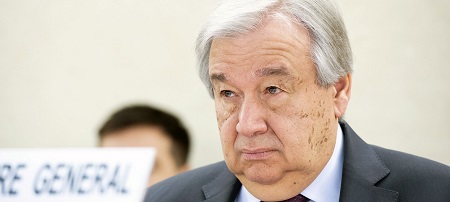At the opening of this 43rd session of the UN Human Rights Council, on 24 February 2020, Secretary-General António Guterres finally issued a formal initiative to consolidate human rights action in the fourth year of his five-year term. The much-welcome initiative bears the title The Highest Aspiration: A Call to Action for Human Rights. The document, billed as a “blueprint for positive change,” reiterates long-established principles within seven timely themes:
- Rights at the Core of Sustainable Development
- Rights in Times of Crisis
- Gender Equality and Equal Rights for Women
- Public Participation and Public Space
- Rights of Future Generations, Especially Climate Justice and
- Human Rights at the Heart of Collective Action
- New Frontiers of Human Rights
The Secretary-General (S-G) characterized the state of today’s world as one of “egregious and systematic human rights violations; rampant impunity; rising hate speech, misogyny, exclusion and discrimination; social polarization and loss of civility; environmental degradation; and unequal access to resources and opportunity. He noted that “We also see the human rights agenda being instrumentalized for political purposes,” amid megatrends such as the climate crisis, population growth and rapid urbanization that are changing our lives.
In the face of these challenges, his appeal broadly refers to “economic, civil, cultural, political and social rights, as well as the right to development”; “freedom of thought, conscience and religion”; “equal participation,” interpreted as including “civic space, including a free and independent media.” The catalog of human rights priorities includes “a safe, clean, healthy and sustainable environment, and for effective individual access to justice and effective remedies” in that specific context; and “to privacy, particularly where personal and health-related data are concerned.”
As welcome as this call is, even if late coming in the S-G’s term, it consistently refers to human rights as a mere “aspiration.” This principled call to human rights, however, does not once mention the “obligation” of states, including the duties to respect, protect and fulfill human rights as binding under treaty. In this light of human rights legal theory and methodology, the proposed actions are similarly broad and vague.
Actions “in the face of ever more complex conflicts raise the spectre of atrocity crimes,” the document notes, but related refugee-and-displacement crises evokes only the need for “extra vigilance.” Topping the called-for actions is a reaffirmed reliance on the Security Council, as if that body had proved at all effective in alleviating, preventing or remedying such grave breaches. It also avoids mentioning the Security Council’s serial failures, grounding the many urgent calls for UN reform. The initiative does not mention the multiple and multi-party violations of occupations, aggressions and annexations, including those that Member States, including permanent Security Council Members, perpetuate in Crimea, Kashmir, Palestine, Tibet and Western Sahara.
The S-G’s initiative neglects to mention the current budget crisis, crippling the UN Human Rights System and the Treaty Bodies, in particular. This comes in the same calendar year that the General Assembly is scheduled to take up the much-anticipated agenda item of “Strengthening and enhancing the effective functioning of the human rights treaty body system” as the base of the legal function and human rights pillar of the UN System. Instead, it concentrates on the Universal Periodic Review and 2030 Agenda, which are largely voluntary in nature and assiduously avoid state obligations.
The initiative could go further to recognize the broken promise of the “longer-term positioning of the sustainable development system” to prioritize human rights commitments and “pool assets across the Organisation,” which the S-G previously called for. This should include recognition that the reporting criteria of states under Human Rights Treaties are far superior, operational and process oriented than the agreed-upon common denominators of Sustainable Development Goal indicators. The current sustainable-development innovation that seeks to harmonize short-term emergency relief with longer-term and institutional-building development approaches within the remedial and preventive human rights framework is also conspicuously unmentioned.
If restoration of the paramountcy of human rights were an objective of this call to action, then a much more strident, practicable and specific set of actions is needed. If we seek positive change, then we must be that change we seek. In the interest of meeting today’s challenges and maintaining integrity of the office and the wider system, the office of the S-G also must be and do more. As a timely starting point and useful framework, the S-G’s call to action also calls for greater specificity and much courage.
Photo: UN Secretary-General António Guterres unveils his blueprint for positive change at the opening of the 43rd session of the UN Human Rights Council, 24 February 2020. Source: UN News.
Download The Highest Aspiration: A Call to Action for Human Rights [FR]
On a related issue, see Habitat International Coalition’s written submission to the current 43rd session of the UN Human Rights Council.














